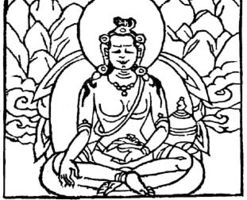Kālacakrapāda
| PersonType | Category:Authors of Sanskrit Works Category:Classical Indian Authors |
|---|---|
| MainNamePhon | Kālacakrapāda |
| MainNameTib | དུས་ཞབས་པ་འཇམ་པའི་རྡོ་རྗེ |
| MainNameWylie | Dus zhabs pa 'jam pa'i rdo rje |
| AltNamesTib | རྣལ་འབྱོར་པ་དུས་ཀྱི་འཁོར་ལོའི་ཞབས · དུས་ཞབས་པ་ཆེན་པོ |
| AltNamesWylie | Rnal 'byor pa dus kyi 'khor lo'i zhabs · Dus zhabs pa chen po |
| AltNamesOther | Manyjuvajra · Cilupa |
| YearBirth | 11th century |
| BornIn | Varendra (a region of northern Bengal) in eastern India |
| TeacherOf | Kha che zla ba mgon po · Avadhūtipa · Śrībhadrabodhi · Nālandāpa · Nāropa · Sādhuputra · Ratnakaragupta · Mokṣakaragupta · Vinayākaramati · Siṃhadhvaya · Anantajaya |
| BDRC | https://www.tbrc.org/#!rid=P4CZ15084 |
| IsInGyatsa | No |
| BnwShortPersonBio | The one known as Kālacakrapāda the Elder (Dus zhabs pa chen po) was born in Varendra (a region of northern Bengal) in eastern India. His father was a Brahmin yogin who practised Black Yamāri (Gshin rje gshed nag po), and his mother was an awareness ḍākinī. They performed a ritual from the Kṛiṣṇayamāri Tantra to ensure the birth of a noble son. The father dreamed of the noble Mañjuśrī entering his wife's belly, and the child was later born together with auspicious signs.
Due to the blessing of noble Mañjuśrī, the child had a bright mind with clear faculties, and took ordination when he was young. He studied many subjects and understanding them all with ease he became a paṇḍita and was known as Cilupa. He heard of Kālacakra from Paṇḍita Ācārya, but was not satisfied, and through the awakening of his previous prayers he developed a powerful wish to go to Sambhala. As his personal deity Tārā would grant the realization of anything he wished, she prophesied that for the benefit of beings he would gather from Sambhala many tantras and bodhisattva commentaries. This is a reference to a particular cycle of commentaries, often known as the bodhisattva trilogy (Sems 'grel skor gsum). Said each to have been written by great bodhisattvas, one is the Vimalaprabhā commentary on Kālacakra, and the other two deal with the Cakrasaṃvara and Hevajra tantras. (Source Accessed October 16, 2019) |
| Other wikis |
If the page does not yet exist on the remote wiki, you can paste the tag |

